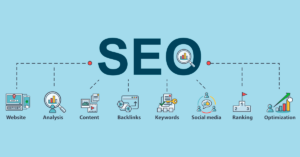5 SEO Best Practices
Subheader
5 SEO Best Practices re: SEO, or search engine optimization, refers to optimizing your website to rank higher in search engine results for keywords relevant to your business. Ideally, these are keywords that your target customers are searching for. SEO is often split into on-page and off-page SEO:
- On-page SEO refers to optimizing elements on your website to help it rank higher in the search engines. These elements can include the content of your page (including images, text, and video), the way you format that content, and even the URLs you use.
- Off-page SEO refers to optimizing your website to rank higher in the search engine, by utilizing ranking factors external to your website. These may include driving links to your website through guest blogs, driving traffic through YouTube videos, and other content marketing initiatives.
There are a wide range of tactics—both on-page and off—that you can use to boost your SEO, but in this article we’re focusing on on-page SEO. Unlike many off-page tactics, which require you to collaborate with other website owners, on-page SEO is entirely within your control.
That means it’s up to you to ensure you’re doing all you can to boost it. You can learn more about this @ Volpreneurship!

Top 5 On-Page SEO Best Practices
Without further ado, here are the top 5 on-page tactics you can leverage to boost your SEO, and how to implement them.
-
Use keywords in your title tags and meta descriptions.
While Google is getting smarter at making connections between similar phrases and keyword synonyms, keywords are still the foundation of SEO. After all, they’re the key topic that your web page is all about.
As such, you need to ensure you’re placing them in the key spots where Google will be looking for them. These spots include your title tag and meta description for each page on your website.
Together, your title tag and your meta description serve as a web page’s billboard in the Google results. These are the title and description you see for a website when you search in Google.
While you’ll see the title tag at the top of the browser window for a website, you typically only see the meta description in the Google results. That’s because both of these tags are added to your page code, rather than the front-end part of your web page that visitors see.
SEO BEST PRACTICE
When adding title tags and meta descriptions, optimize them for rankings by including a keyword that describes your page content. Then, optimize them for click-throughs by making them sound interesting. For instance, we want this blog article to rank for keywords like “on-page SEO” or “SEO Best Practices.” So, we’ve made our title tag and meta description the following:
- Title Tag: How to Implement Top 5 On-Page SEO Best Practices
- Meta Description: Like any business, you want your website to grab qualified consumers. To truly optimize your SEO opportunity, start where it all began, right on your page. Use these 5 SEO best practices to boost your ranking and optimize your content
Add unique title tags and meta descriptions to all of the pages on your website. Make them interesting and keyword-rich. Also, make sure you don’t go above the character limits of what appears in Google. Keep your title tags below 60 characters and your meta descriptions below 160 characters.
-
Keep your URLs short but descriptive.
Your URL structure is another prime place to insert keywords. According to studies, including keywords in your URL does appear to be a ranking factor.
However, that doesn’t mean you should go crazy and add tons of keywords to your URLs. Apply the same discretion and restraint you used with your title tags and meta descriptions.
In fact, it’s common for a URL to look a lot like a shorter version of the title tags.
Fortunately, other digital experience platforms like Sitecore, auto-generate URLs based on the name of your items and their position within your site hierarchy. That’s why our URL above includes the /blog/ folder and many of the words in our article title.
However, you should always double-check before publishing that your URL follows other SEO best practices, which we’ve included below.
- Keep your URLs short but descriptive.
- Include your main keyword in the URL.
- Use hyphens to separate words.
- Use lowercase letters.

- Add alt text to all of your images.
Chances are your website isn’t a dense pile of text-only content. You also have images, icons, and banners to make it visually interesting for your visitors.
Make it interesting for search engines, too, by telling them what these images are about. Search engines can’t see (at least, not yet), but they can read. By adding alt text (short for “alternative text”) to your images, you can describe your image to the search engines.
Even better, alt text makes your website more accessible to blind and visually impaired users, which represent over 8 million Americans. Their screen readers will read your alt text aloud. Add alt tags to your images, and everyone can enjoy the visual experience of your website—whether they see it with their eyes or their ears.
Best of all, alt text helps your images appear in Google Image Search, which accounts for over 20% of online searches.
Your alt text should describe the image as accurately as possible, and include keywords where relevant.
To give your image SEO an extra boost, use keywords in the file name of your image, too (feel free to copy and paste what you used for the alt text).
-
Optimize the anchor text for internal links.
Internal links describe any link on your website that links to another page on your website. You’ll see your internal links in your main navigation, in your site menus, and in your content.
When you set up your website, you’ll want to include your most important internal links in your main navigation and footer. This placement likely makes them the most-linked-to pages on your website. Google will interpret that to signify that these pages are very, very important (which will hopefully encourage them to rank those pages higher for relevant keywords).
Whenever you link to internal pages within your content, you’ll want to optimize your anchor text to give Google more context about what the linked page is about. Anchor text refers to the text that is hyperlinked.
When adding anchor text, include keywords when it makes sense, and avoid generic anchor text that doesn’t say much about the link, such as “click here.”
-
Add appropriate schema markup.
Schema markup refers to code you can add to your web pages to provide more context about the content to Google and other search engines. Schema is based on a vocabulary developed by Google, Bing, Yandex, and Yahoo! That means that when you add schema to your website, you’re speaking the search engines’ language. That can only spell good things for your SEO.
Schema will not appear on the page your visitors see, as it lives in the code. You can add schema to markup a variety of content you might have on your web page, such as ratings and reviews, recipes, job postings, and more.
Schema provides more information to search engines. That alone makes it useful for SEO, as the better a search engine understands your web page, the better job it can do at ranking you for the appropriate keywords.